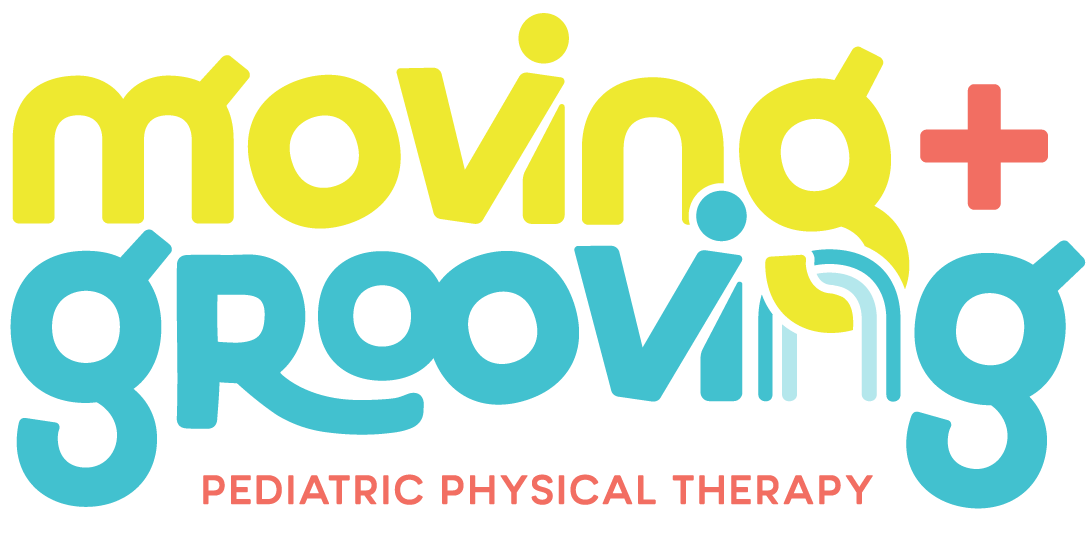
Torticollis and Plagiocephaly
Torticollis, AKA wry neck or twisted neck, presents as a head tilt and/ or a head rotation preference. Maybe you’ve noticed that whenever you take a picture of your child, he already has mastered a cute head tilt, without your help. This can be hard to notice without looking for trends in each position such as on their back, tummy, sitting, crawling and standing. If you notice a preference to have their head in one position most of the time, or moves their body to avoid looking or rotating to one side, your child may have torticollis.

Frequently, plagiocephaly, or a misshaped skull, tags alongside torticollis, as babies skulls are very soft and malleable with shifting skull plates. If the head is always tilted or rotated in one direction, the skull can start to become indented at the place where the most pressure is applied on it. In addition to a flat spot, the pressure from the skull shifting inward in one section may cause an outward shift of the skull, located at another location on their head or face. Plagiocephaly can also present itself based on birth history, including a breeched position, a first child being born to their mother, petite mothers, children born as multiples, and a long length of the child’s body. It is more common in boys than girls. Plagiocephaly is also noted in children who spend a lot of time on their back. This is particularly seen in infants who don’t tolerate tummy time or have difficulty sleeping and are left in a swing to help soothe them to sleep.
The good news is that these conditions are very treatable. Both of these conditions, if caught early enough, can be managed by small changes to your child’s environment and repositioning off of their back throughout the day.
Before you hit the panic button, assessing and implement the following:
Is your child able to actively turn their head or tilt their head in the opposite direction? You can assess this by using your voice, face, a highly contrasted picture, or music toy for your child to track from their preferred to their non preferred side.
Can they achieve this full range of motion if you guide their head in that direction? Try this lightly by placing your hand on the back of their skull and attempt to have their nose reach over either shoulder, and place your hand on the top, outside of their skull and the top of their shoulder, and see if you can bring their nose to a 45 degree angle compared to their shoulders.
Keep them off of their back throughout the day. Have you implemented any play in tummy time or side lying? These are age appropriate positions for infants and also keep pressure off of the skull.
Change the location of the items they like to look at the most? Such as:
Car seat placement- move them so that they must look to their non preferred side to see their hanging toys or the window
Naps and overnight sleeping – when you open the door to pick them up after sleeping, lay them down so that in order to look at you, they must look through their non preferred side. Baby should be sleeping flat on their back, and can also be on their tummy if they are able to lift their head up and clear their airway, with nothing under their head. The higher their head is elevated above the rest of their body, the more pressure is placed through the skull and contributing to the severity of the plagiocephaly.
Mealtime- sit on their non preferred side during mealtime while you engage with them. Present the bottle to their non preferred side.
After bath/ Before sleeping- perform gentle massage with your forefinger in a circular motion on the area that seems tightest on the neck, shoulder or back region.
What happens if I don’t intervene with these conditions?
Due to children being born with more cartilage and shifting skull plates in their head, intervention is best when the condition is caught early on. If either of these conditions are left untreated, are severe in nature, or caught at a later stage, other interventions may need to be added, including a helmet (AKA a DOC band), and/ or surgery. They can also lead to an array of issues, including, but not limited to, the following:
Scoliosis
Feeding difficulties due to the shifting of the jaw and closing of the airway to easily swallow and breathe
Facial feature asymmetries
Neck, Back, Jaw pain
Higher risk for head injury due to standard helmets not being appropriately fit to the skull
Sunglasses and corrective lenses not fitting face

Difficulties with:
Vision and reading, which can cause delays in learning
Turning head to assess for people or oncoming traffic behind them
Lifting arms up overhead
Athletic activities that require hand/eye or hand/foot coordination, flexibility, balance
It is highly recommended you implement the aforementioned strategies, and then contact Moving and Grooving Pediatric Physical Therapy for a free consultation, to see if we can be of further assistance. If a DOC band is recommended by your therapist, our preferred vendor is Cranial Technologies. They offer a free evaluation and provide a report which indicates the severity of the condition, whether or not your child needs a DOC band, and how many weeks it is anticipated they would need this. Wear time is 23 hours/day and does not interfere with the other interventions utilized in your physical therapy sessions. You can learn more information about the DOC band here: https://www.cranialtech.com/

Other Resources:
https://www.choosept.com/guide/physical-therapy-guide-torticollis
Our staff has been trained by Cindy Miles, PT, PhD, an expert on torticollis and plagiocephaly. Learn more here:
https://cindymiles.com/cindy-miles-torticollis-course/
